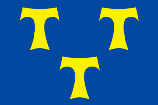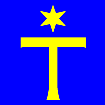A heraldic term sometimes used when a cross (either plain or decorated) does not extend to edges of a shield,
banner of arms or flag (see also ‘couped 2)’ and ‘Greek cross’).
Please note that, unless referring to a plain cross, this term is always
accompanied by a further description, for example a “cross crosslet couped” as shown in the following definition.


Example; Putative Flag of Constantine the Great c325AD (fotw)
Cross Crosslet
The heraldic term for a cross which does not usually extend to the edges of a shield, flag canton or panel,
but whose arms have a short transverse bar inserted (see also ‘cross 2)’).

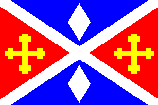

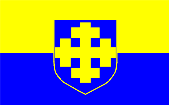
Example; Flag of Echt-Susteren, The Netherlands (fotw);
Arms and Flag of Slupca, Poland (fotw)
Cross-Fitchy
The heraldic term for a cross which does not usually extend to the edges of a shield, flag, canton or panel,
and which may have plain or decorated ends, but whose vertical arm comes to a point at its base (see also
‘cross 2)’ and ‘cross of Santiago’).




Flag of Bernissart, Belgium (fotw); Flag of Avinyó, Spain (fotw)
Please note that, unless referring to a plain cross, this term is always accompanied
by a further description, for example a “cross crosslet fitchy”.
Cross Fleury Fitchy
See ‘
cross of Santiago’.


Arms and Flag of Torrão, Portugal (fotw)
Cross Fleury (or Flory, Floretty or Fleuronny)
The heraldic term for a cross which does not usually extend to the edges of a shield, flag, canton or panel, but
whose ends are formed by fleur-de-lis – a fleur-de-lis or fleury cross, avis cross, or
cross of calatrava (see also ‘avis cross’, ‘cross 2)’,
‘Dominican cross’,
‘cross of Calatrava’,
‘fleur-de-lis’ and ’fleury’)

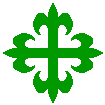
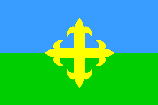

From left: Example; Suggested Flag of the Avis Order, Portugal (fotw); Flag of Almagro, Spain (fotw); Flag of
Guriezo, Spain (fotw); Flag of The Portuguese Legion c1928 – 1974 (fotw)
Cross Gringolée
Cross Gyronny
The heraldic term for a cross that may or may not extend to the edges of a shield,
flag or panel, but is composed of two tinctures meeting at the centre point and
alternating either side of the vertical and horizontal meridians (thus giving it a
three-dimensional appearance) – a gyronny cross - see ‘gyronny’ and compare with
‘cross counterchanged’ in ‘appendix VIII’ (also ‘Dominican cross’, ‘faceted’ and ‘tincture’).

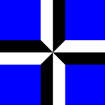
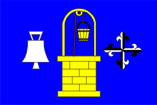
Example; Flag of Kreis Safien, Switzerland (fotw);
Flag of Studnice, Czech Republic (fotw)
Notes
a) Unless describing a plain cross throughout, this term should always be
accompanied by a further description, for example a “cross fleury gyronny couped”.
b) A cross whose centre is obscured by a charge (as illustrated below) could be described as either a cross gyronny or a cross-counterchanged, however, the term ‘cross quartered’ has now come into use - see ‘cross quartered’.
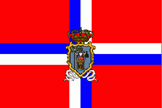
Flag of Santa Cruz de La Palma, Spain (Klaus-Michael Schneider)
Crosslet
Cross Moline
The heraldic term for a cross which does not usually extend to the edges of a shield, flag, canton or panel,
but whose ends are split into two curved pieces – an anchor or moline cross (see also
‘cross 2)’ and
‘snakehead cross’).

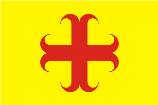
Flag of Annœullin, France (fotw)
Cross of Calvary (or Cross of Crucifixion)
The heraldic term for a Latin cross that does not usually (although it may) extend to the edges of a shield,
flag, panel or flag, but which is mounted on three steps steps – a cross of crucifixion, a calvary cross or calvary
(see also ‘Latin cross’).

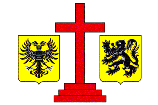
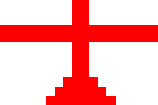
From left: Example; Flag of Geraardsbergen, Belgium (fotw); Flag of
Fulleda, Spain (fotw)
Cross Pomel (Pomée, Pommetty or Pommelly)
Cross Pattée (or Patée, Patty or Paty)
The heraldic term for a cross that may or may not extend to the outer edges of a shield, flag, canton
or panel, whose arms are generally (but not exclusively) flat-ended but which is wider at its outer ends than it is in the centre.
The arms can be straight-sided or curved throughout their length, or they can be straight-sided and parallel
until being flared at their outer end – a cross formée, formé or formy, a pattée, patée, patty or Paty cross, a
formée, formé or formy cross, or an iron, Hanseatic, Hansa, cavalier or cavalier’s
cross – but see ‘Maltese cross’, ‘rounded cross’ (also
‘cross 2)’ and
‘Cross of the Order of the Knights of Christ’).

![[Wallis & Futuna]](../images/v/vxt-d592.gif)
![[Guernsey civil ensign]](../images/v/vxt-d592a.gif)
![[Cr. Jensen houseflag]](../images/v/vxt-d592b.gif)
From left: example; Flag of Wallis & Fortuna; Civil Ensign of Guernsey; House flag of Chr. Jensen, Denmark (fotw)
Cross Potent (or Potence)
The heraldic term for a cross which does not usually extend to the edges of a shield, flag, canton or panel,
but whose arms terminate in a transverse bar – a cross potence, or potent, or a crutch or Teutonic
Cross (see also
‘cross 2)’ and ‘cross-cantonée’
and ‘potent 2)’).

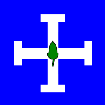
From left: Cross-Potent example; Flag of Goumoëns-la-Ville, Switzerland (fotw)
Cross-Potent Cantonée
See ‘Cross Potent’ and ‘Cross-Cantonée’ in ‘appendix VIII’.

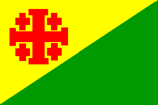

Example; Flag
and Arms of Niawier, The Netherlands
Cross Tau
Cross-Voided
The heraldic term for a cross that may or may not reach the edges of a shield, banner of arms or flag and
may be either closed or open-ended, but from which the centre is removed so that the field may be seen through it
(see also ‘cross of athletics’ and ‘voided’)

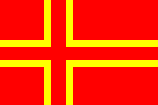
 From left: example; Flag of the Mouvement Normand, France (fotw); Flag of De Haan, Belgium (fotw)
From left: example; Flag of the Mouvement Normand, France (fotw); Flag of De Haan, Belgium (fotw)
Notes
a) Unless referring to a plain cross, this term is always accompanied
by a further description, for example "a cross pattée voided".
b) This term is sometimes (incorrectly used to describe a
Cross of the Order of the Knights of Christ as illustrated below – see ‘Cross of the Order of the Knights of Christ’.
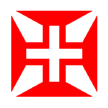
A banner of the Order of the Knights of Christ (fotw)
Latin Cross
The heraldic term for a cross that does not usually extend to the edges of a shield, flag, panel or flag, but whose
horizontal arm is shorter than its vertical and which is set above the centre line – a long cross (see also
‘Greek cross’ and ‘cross 2)’)






From left: example; Flag and Arms of Budinšcina, Croatia (Fame); Flag of the Muzzle Loaders of Manitoba, Canada;
Arms and Flag of Vila de Ala, Portugal (Antonio Martins)
Notes
1) Unless referring to a plain cross, this term should always
accompanied by a further description, for example a “Latin cross treflee” as
illustrated below.

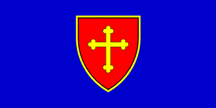
Arms and Flag of Negoslavci, Croatia (fotw)
2) In vexillological terms a Latin cross throughout becomes
an off-centred cross – see ‘off-centred cross 2)’ (also ‘throughout’).

Flag of Thunstetten, Switzerland (fotw)
Introduction | Table of Contents
| Index of Terms | Previous Page | Next Page

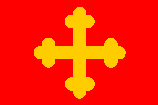
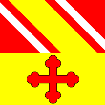




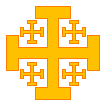
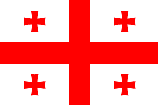

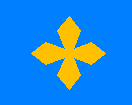

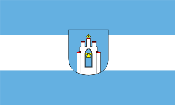
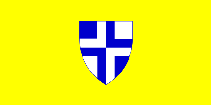

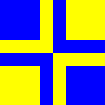
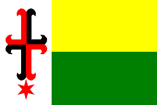

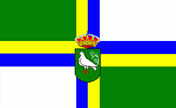
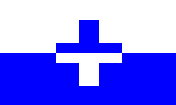





















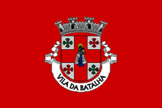


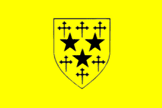






![[Lagoa Portugal]](../images/v/vxt-d2597.gif)
![[Lagoa Portugal]](../images/v/vxt-d2599.gif)
![[Lagoa Portugal]](../images/v/vxt-d2598.gif)

![[Wallis & Futuna]](../images/v/vxt-d592.gif)
![[Guernsey civil ensign]](../images/v/vxt-d592a.gif)
![[Cr. Jensen houseflag]](../images/v/vxt-d592b.gif)






